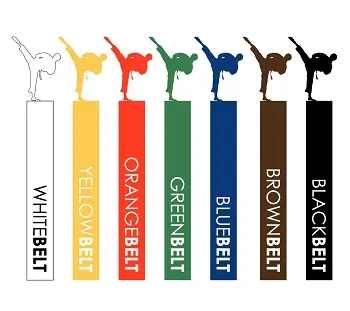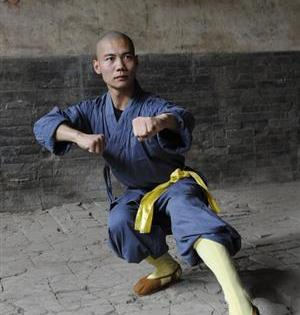
Our martial arts program combines both very practical applications of Kung Fu for self defense and traditional Kung Fu forms with their inherently beautiful physical movements. Our program consists of 16 different belt levels. Each belt level has its own unique martial arts form. In order to pass each belt level, the students need to master different aspects of “The Basics.”
“The Basics” include learning techniques, stances, applications, strength and inner energy (Qi) in order to understand and utilize authentic martial arts that can work in a defensive situation or in a competition. Pure Shaolin Kung Fu’s goal is to provide comprehensive training to its students, ranging from self-defense and self-discipline to providing health benefits. It is then up to each individual student to achieve his or her individual goals.

The origins of Chinese martial arts can be traced over 5,000 years ago to self defense needs, hunting activities and military training in ancient China. Hand to hand combat and weapons practice were important components in the training of Chinese soldiers. From this beginning, Chinese martial arts developed by incorporating different philosophies and ideas into its practice–expanding its purpose from self defense to health maintenance and finally, as a method of self-cultivation
Traditional Kung Fu forms connect different movements that are based on combat skills. Each movement has a purpose, whether to win a match offensively or provide defensive movements from an attack. Traditional Chinese philosophy discourages the use of fighting as it is considered uncultured. Historically, the teachers of Kung Fu created these forms to weaken aggressive desires in individuals so that order and balance in society could be maintained.
When experts practice their Kung Fu forms, they do not need an actual enemy to practice combat, they focus on how to find each movement’s core and how to achieve perfect balance. A technique to fight and defeat an enemy does not serve to promote peace for all human beings in the world. The Kung Fu form is characterized by balance of the whole body, a calm mind, integrated breathing, and the extension of natural energies. The Kung Fu form is flowing and graceful.
Not all Kung Fu schools use the belt system. As mentioned above, many schools prefer the traditional system of a signed scroll. Others take it to a more intimate level where only the master or instructor fully understands the level of skill and experience of their students.
The schools that do use the colored belt system split the colors in three major categories: novice belts, intermediate belts, and advanced belts.
Novice Belts : yellow, orange and blue. During these stages a student is expected to learn the basic strikes, defenses, counters, and stances of Kung Fu. Everything is done in drills and basic sparring. It normally takes around 1 to 2 years to go through all three belts in this category.
Intermediate Belts : blue (optional), brown. During this stage the student begins weapons training as well as the adaption of more complex techniques.
It is during these stages that the instructor begins bestowing some of the more intricate lessons of Kung Fu. 2 to 3 years is the average time to go through this category
Advanced Belts : black. There are several degrees of black. Some schools go up to nine degrees. When a person has reached this category they are given permission to begin teaching their own students.
It is also during this stage that they learn unique katas, philosophical concepts, and begin their contribution to Kung Fu.
Attaining a black belt in Kung Fu is not the end of training – there are higher degrees and many Kung Fu artists are encouraged to begin their training in other styles once they have achieved a high enough black belt ranking.
| Rank Name | Description | Color |
|---|---|---|
| No Rank Title - Novice Level | Introduction and White Sash Level | No Color |
| Si Di / Si Mui | Beginning Level | Yellow Sash, Orange |
| Si Hing / Si Je | Intermediate Level | Blue Sash, Dark Blue, Purple |
| Si Suk / Si Goo Mui | Intermediate / Advance Levell | Brown Sash, High Brown, Apprentice Black Sashr |
| Si Fu | Instructor Level | Black Sash, 1st Black Sash, 2nd Black Sash, 3rd Black Sash |
| Si Bok / Si Di Goo | Senior Instructor Levell | 4th Black Sash, 5thBlack Sash, 6th Black Sash |
| Si Gung / Si Poo | Master Instructor Level | 7th Black Sash, 8th Black Sash |
| Si Tai Gung / Si Tai Poo | Grand Master Instructorl | 9th Black Sash, 10th Black Sashr |
| Si Jo | Founder of a particular systeml | Completed |
Si Jo - Founder of New Style or New Approach to old method - Usually presented by former Grand Master or Master Instructor, to pass on, or teach a particular Family Style System, a new name to style might be given, this had been done for many generations to hide the secrets of kung fu from outsiders and those un-worthy to receive the inner workings, special training methods, ancient philosophies, and more.
White Belt : Kindergarten through 2nd Grade – Elementary school
Orange Belt : 3rd through 5th Grade – Elementary school
Purple Belt : 6th through 8th Grade – Middle schooll
Brown Belt : 9th through 12th Grade – High School
Black Belt : Undergraduate – University or College
Degrees of Black : Graduate study towards MA & Ph.D.
This is not an exact comparison, but a rough model to give one an idea of their level of advancement based on our familiar educational system. White belt through Yellow belt is similar to a grammar school education. Here the student learns the rudimentary basics. From junior high through high school or Green belt through Brown belt, the student works to develop proficiency in the basic techniques. Black belt represents one’s introduction to higher learning, for example: undergraduate study leading to a Bachelor’s Degree. Progressing through the various degrees is representative of graduate study leading to a Master’s Degree or further yet, to a Ph.D.